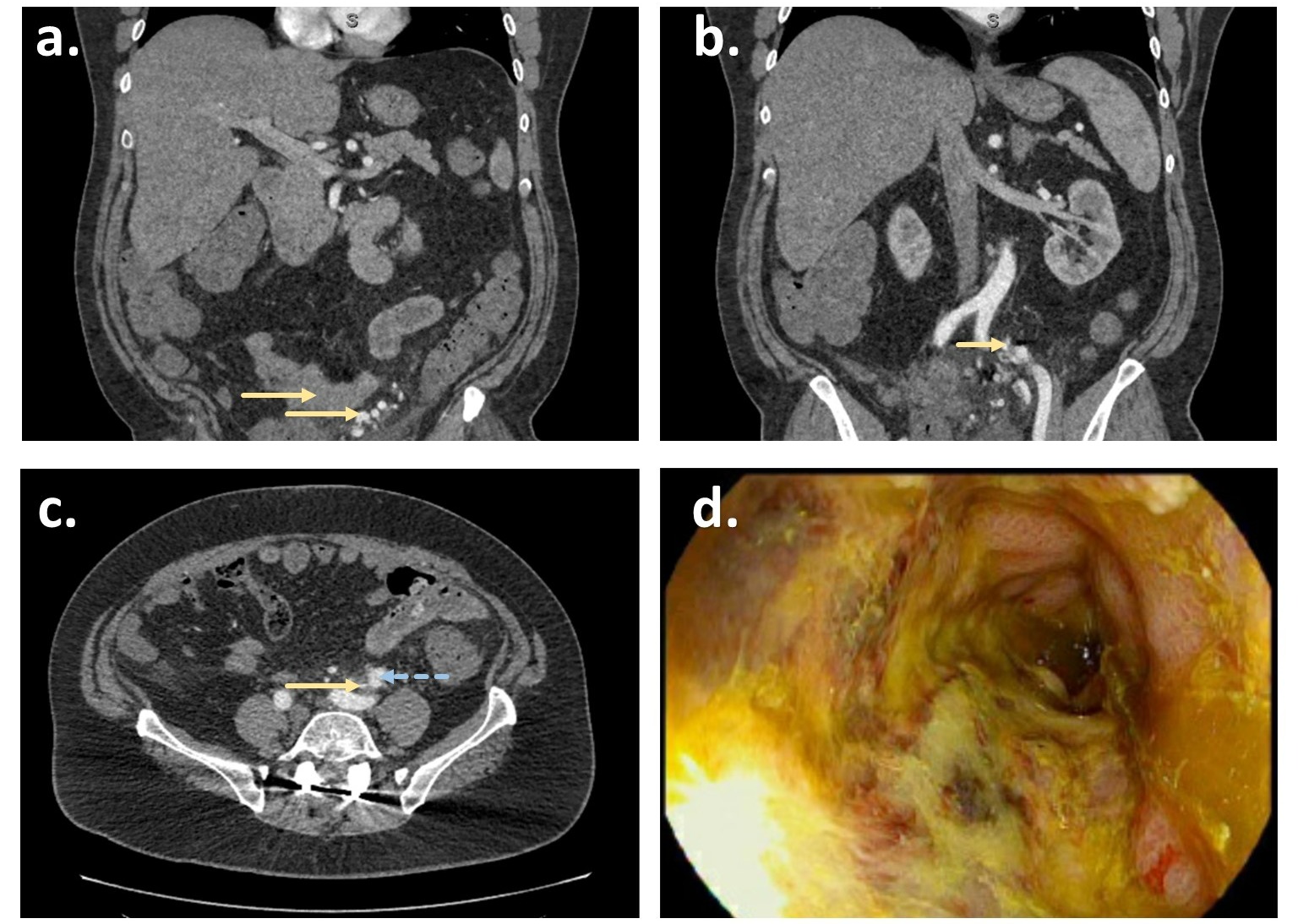Back
Poster Session C - Monday Afternoon
C0111 - Inferior Mesenteric Arteriovenous Fistula Treated with Embolization
Monday, October 24, 2022
3:00 PM – 5:00 PM ET
Location: Crown Ballroom

Parth M. Patel, MD
Henry Ford Jackson
Jackson, MI
Presenting Author(s)
Parth M. Patel, MD1, Harjinder Singh, MD1, Zarqa Yasin, MD1, Hassan Zreik, MD1, Parth Y. Patel, MD2, Merritt Bern, MD1
1Henry Ford Jackson, Jackson, MI; 2Henry Ford Hospital, Detroit, MI
Introduction: Inferior mesenteric arteriovenous fistulous malformations are a rare yet reversible cause of ischemic colitis. They can cause increased outflow of blood in the venous circulation and predispose to colon ischemia. We report a case of inferior mesenteric arteriovenous fistula causing ischemic colitis in an atypical distribution in the IMA territory.
Case Description/Methods: A 50-year-old gentleman presented to the emergency room with a 3-week history of abdominal pain and bloody diarrhea. His symptoms started with a dull pain, 8/10 in intensity, with radiation to his lower back. He had also been having a low appetite for the duration of his abdominal pain. He described having around ten bowel movements daily with blood mixed with mucus. CT abdomen showed diffuse circumferential thickening involving the entire sigmoid colon, extending to the upper rectum suggesting non-specific colitis. He came to the hospital 2 weeks prior to his presentation and underwent a colonoscopy which grossly showed diffuse severe inflammation in the distal descending colon, sigmoid colon and proximal rectum, till 30 cm from the anal verge suggesting left-sided colitis. Biopsied from the region showed evidence of ischemic colitis. His CT-angiography showed engorgement of the IMA and IMV, with an early contrast in IMV which suggested IMA to IMV AV fistula within the left hemipelvis. That suggested vascular malformation as the cause of the colorectal findings. Patient subsequently underwent embolization of two branches of IMA with stent placement in IMA, causing closure of the AV fistula. Patient tolerated the procedure without any complication.
Discussion: Ischemic colitis is most commonly seen in the watershed areas of the colon such as splenic flexure and rectosigmoid junction due to arterial anastomosis between the mesenteric arteries supplying the colon. In these situations, the colonic involvement is focal involves these specific segments. In this case, patient had diffuse gross ischemic findings from the distal rectum extending to descending colon involving the whole part of ischemic artery supply which is atypical for the distribution of colonic ischemia. In such situations, CT angiography comes as a diagnostic tool for identifying the pathology and in this situation it showed AV fistula between IMA and IMV which hampered the colonic blood supply to the extent to cause ischemic colitis with symptoms.

Disclosures:
Parth M. Patel, MD1, Harjinder Singh, MD1, Zarqa Yasin, MD1, Hassan Zreik, MD1, Parth Y. Patel, MD2, Merritt Bern, MD1. C0111 - Inferior Mesenteric Arteriovenous Fistula Treated with Embolization, ACG 2022 Annual Scientific Meeting Abstracts. Charlotte, NC: American College of Gastroenterology.
1Henry Ford Jackson, Jackson, MI; 2Henry Ford Hospital, Detroit, MI
Introduction: Inferior mesenteric arteriovenous fistulous malformations are a rare yet reversible cause of ischemic colitis. They can cause increased outflow of blood in the venous circulation and predispose to colon ischemia. We report a case of inferior mesenteric arteriovenous fistula causing ischemic colitis in an atypical distribution in the IMA territory.
Case Description/Methods: A 50-year-old gentleman presented to the emergency room with a 3-week history of abdominal pain and bloody diarrhea. His symptoms started with a dull pain, 8/10 in intensity, with radiation to his lower back. He had also been having a low appetite for the duration of his abdominal pain. He described having around ten bowel movements daily with blood mixed with mucus. CT abdomen showed diffuse circumferential thickening involving the entire sigmoid colon, extending to the upper rectum suggesting non-specific colitis. He came to the hospital 2 weeks prior to his presentation and underwent a colonoscopy which grossly showed diffuse severe inflammation in the distal descending colon, sigmoid colon and proximal rectum, till 30 cm from the anal verge suggesting left-sided colitis. Biopsied from the region showed evidence of ischemic colitis. His CT-angiography showed engorgement of the IMA and IMV, with an early contrast in IMV which suggested IMA to IMV AV fistula within the left hemipelvis. That suggested vascular malformation as the cause of the colorectal findings. Patient subsequently underwent embolization of two branches of IMA with stent placement in IMA, causing closure of the AV fistula. Patient tolerated the procedure without any complication.
Discussion: Ischemic colitis is most commonly seen in the watershed areas of the colon such as splenic flexure and rectosigmoid junction due to arterial anastomosis between the mesenteric arteries supplying the colon. In these situations, the colonic involvement is focal involves these specific segments. In this case, patient had diffuse gross ischemic findings from the distal rectum extending to descending colon involving the whole part of ischemic artery supply which is atypical for the distribution of colonic ischemia. In such situations, CT angiography comes as a diagnostic tool for identifying the pathology and in this situation it showed AV fistula between IMA and IMV which hampered the colonic blood supply to the extent to cause ischemic colitis with symptoms.

Figure: Figure 1. a. Early filling of dilated mesenteric veins (bottom arrow) with adjacent bowel wall edema due to venous congestion (top arrow) b & c. inferior mesenteric artery (arrows) adjacent to ill-defined area of contrast (dashed arrow) thought to represent arterio-venous fistula d. view from sigmoidoscopy showing ischemic colitis in the sigmoid colon
Disclosures:
Parth Patel indicated no relevant financial relationships.
Harjinder Singh indicated no relevant financial relationships.
Zarqa Yasin indicated no relevant financial relationships.
Hassan Zreik indicated no relevant financial relationships.
Parth Patel indicated no relevant financial relationships.
Parth Patel — NO DISCLOSURE DATA.
Merritt Bern indicated no relevant financial relationships.
Parth M. Patel, MD1, Harjinder Singh, MD1, Zarqa Yasin, MD1, Hassan Zreik, MD1, Parth Y. Patel, MD2, Merritt Bern, MD1. C0111 - Inferior Mesenteric Arteriovenous Fistula Treated with Embolization, ACG 2022 Annual Scientific Meeting Abstracts. Charlotte, NC: American College of Gastroenterology.
